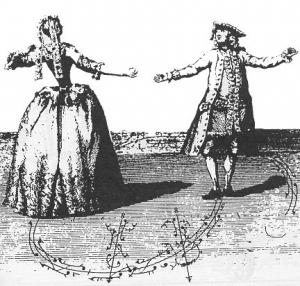- Historical Dance
- Jazz Age Social Dancing ("The Modern Dances")
- Ragtime Dance - the One Step
- Regency Dance
- "Mr Nelson's System of Simplified Regency Dance"
- An Analysis of Country Dancing - 1808
- Cotillions and Country Dances 1792
- Elements of the Art of Dancing - 1822
- The Complete System of English Country Dancing - 1815
- The Scholar's Companion - Cotillions and Country Dances - 1796
- Thos Wilson's Quadrille Instructor - Ca 1816
- Thos. Wilson's Description of Regency Waltzing - 1816
- Treasures of Terpsichore - 1816
- Victorian Dance
3. Bourée Dances (A bit of Baroque in 3/4 Time)
In the 18th Century, in the period often referred to as "Baroque", a different dance aesthetic prevailed than was found in the "Romantic" era of the early 19th Century.
Regency dance, while fairly formal by our standards, was quite simple, energetic and direct by the standards of the time. The Baroque dance aesthetic was much more about being contained, smooth and graceful, and every motion, including those of the arms, was intended to support a striking visual impression. Modern ballet is an outgrowth of the courtly dancing of this period. Baroque dancers were dancing for those who were watching, and not themselves.
 I say this by way of introduction to the 18th Century dances that are popular with those doing "Regency Dance" (e.g Well Hall, Mr. Beveridge's Maggot etc.). Such quaint and antique dances would have been banished from the fashionable ballrooms of Bath or Almack's, but may well have persisted in more out of the way country places. Whether they persisted or not, lots of people like them (myself included), so I will provide some guidelines for incorporating them, with plausible steps, into a ball program that also includes Regency Country Dances with steps.
I say this by way of introduction to the 18th Century dances that are popular with those doing "Regency Dance" (e.g Well Hall, Mr. Beveridge's Maggot etc.). Such quaint and antique dances would have been banished from the fashionable ballrooms of Bath or Almack's, but may well have persisted in more out of the way country places. Whether they persisted or not, lots of people like them (myself included), so I will provide some guidelines for incorporating them, with plausible steps, into a ball program that also includes Regency Country Dances with steps.
The ultimate Baroque dance was the Minuet. In it's pure form it was a dance performed by one couple (and only one couple) while the entire room looked on. It was graceful and controlled -- it could be choreographed or improvised with the lady following and mirroring the gentleman. It generally opened the ball, and took rather a long time and a great deal of training, and would just not work with a modern dancing crowd.
The term "Minuet" might also be applied to a variety of multi-couple figure dances, in the three-four timing of the minuet. However, for clarity I will not use that term for figure dances. I will call them by the primary step I will prescribe for them, the Bourée.
The Pas de Bourée is a marvelously flexible traveling step. You start with the right heel resting near the left instep, then rise onto the toes, stepping first with the right foot, walk on your toes some number of steps, and then drop down to the starting position, bending the knees to accentuate the down motion and make it smoother and more graceful (see the illustration for foot position and knee bend). Repeat as needed. I say "some number of steps" as you can do the Pas de Bourée, depending on the music, with two, three or four steps before the downward knee-bending drop. For the purposes of these dances, do three steps.
Note on the timing. There is no time allotted in the music for the up-down. Each beat is a step, but the bob happens between beats. The "up" happens simultaneously with the first step. The challenge in this step is to do this quickly, yet gracefully without making it seem rushed.
Here's a cheat: your calves may not be as resilient as those of the dancers of the Baroque era. If you can't "keep it up", then you could just walk and then accentuate the knee-bend dip and return to the starting position after every third step. However, I encourage you to give it your best effort and see what your muscles can accomplish if challenged.
And while we are cheating, and if all this is too much to manage; (and having these dances on a Regency program is in itself a cheat)just think "One-two-three-dip, one-two-three-dip" as gracefully as you can muster, and not worry about exactly what your feet are doing.
An important part of the 18th Century dance aesthetic is the motion of the arms. When you stand, I would encourage you to carry your arms outward, in a rounded posture and gracefully gesture towards your fellow dancers at appropriate points in the dance. This is better demonstrated than described, though the illustration should give a general idea.
Of course, if we are portraying Regency era people doing old-fashioned dances, I suppose we wouldn't do all that Baroque hand-jive, even if we were doing the old steps and figures. Oh well.
There are a dizzying variety of Baroque steps, and a full Baroque dance program would require their inclusion. However, since the purpose of this exercise is not to recreate the Court of the Bourbons, but to shoehorn a few popular "antique" dances into a Regency program; and they seem like they could be got through with just a Bourée and a bit of aristocratic attitude, I think I will leave it at that.
The video below incorporates Pas de Bourée with several other steps, but should give a general sense of the step.
